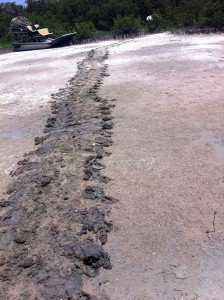 The future for space gardening is bright. And while the ability to grow food in microgravity is an important step on the path to Mars, it also has big implications for farmers – and eaters – here on Earth.
The future for space gardening is bright. And while the ability to grow food in microgravity is an important step on the path to Mars, it also has big implications for farmers – and eaters – here on Earth.
Astronauts Scott Kelly, Kjell Lindgren and Kimiya Yui got the first taste of space-grown food Aug. 10 when they harvested and then sampled lettuce leaves grown on the International Space Station. The “Outredgeous” red romaine lettuce was cultivated in orbit inside the Veggie plant growth system. This morning, the Veggie team at NASA’s Kennedy Space Center harvested lettuce from a ground-based system that otherwise was identical to the small crop grown on the station.
“Veggie has shown us we can grow plants in space pretty darn similarly to how we do on Earth,” Dr. Gioia Massa, the Veggie lead scientist for NASA at Kennedy, said at an employee briefing that included several members of the Veggie team.
“NASA has a huge heritage and legacy of innovation; we have a culture of innovation,” said the center’s deputy director, Janet Petro. “We know the ISS is a great research platform in low-Earth orbit. As we move out to Mars we’re going to have to be ‘Earth-independent.’”
In addition to the benefit to future space explorers, there are clear benefits on Earth, too. As the global population increases, the capability to grow more food crops in tighter spaces becomes more and more important.
“NASA’s Commercial Crew Program is working hand-in-hand, connected with the research aboard ISS and the agency’s efforts to take humans to Mars,” said Lisa Colloredo, associate director of the program. She pointed out that once commercial spacecraft are flying people to the station, the four-person crews will extend the amount time astronauts will be able to spend on research.
Veggie’s success up to this point has provided a lot of confidence that it is possible for space crews to grow their own food, Massa added. Future crews on the International Space Station and on an eventual journey to Mars will be able to rely on freshly grown produce to enhance their diet and provide the psychological boost that comes from tending to a small crop in the otherwise sterile environment of a spacecraft.
“It’s off the Earth, for the Earth – and for the future,” Massa said.



 The exact form of the Extreme Access Flyer isn’t known yet, but engineers at Swamp Works are steadily progressing through prototype designs to invent a flying robotic prospector that can be launched to other worlds and take samples from areas rovers can’t reach. The craft would fly hundreds of short sorties from a lander to gather samples from surrounding areas to find out where the valuable resources are on Mars, asteroids or the moon. The Flyer could also explore giant lava tubes on other worlds to find out whether they are suitable for astronauts and habitation modules.
The exact form of the Extreme Access Flyer isn’t known yet, but engineers at Swamp Works are steadily progressing through prototype designs to invent a flying robotic prospector that can be launched to other worlds and take samples from areas rovers can’t reach. The craft would fly hundreds of short sorties from a lander to gather samples from surrounding areas to find out where the valuable resources are on Mars, asteroids or the moon. The Flyer could also explore giant lava tubes on other worlds to find out whether they are suitable for astronauts and habitation modules. 








 A team of students working with Earthrise Space Foundation evaluated a rover of their own design in the regolith simulant bin at Swamp Works at NASA’s Kennedy Space Center in Florida recently as the team pushes toward a flight-ready version they hope to launch to the moon on a private mission competing for the Google Lunar X Prize. The rover, parts of which are 3D printed, is 18 inches long and uses four wheels for movement. It also features a pair of lenses and a head that lifts and lowers. It is powered by batteries and solar arrays built into it its chassis.
A team of students working with Earthrise Space Foundation evaluated a rover of their own design in the regolith simulant bin at Swamp Works at NASA’s Kennedy Space Center in Florida recently as the team pushes toward a flight-ready version they hope to launch to the moon on a private mission competing for the Google Lunar X Prize. The rover, parts of which are 3D printed, is 18 inches long and uses four wheels for movement. It also features a pair of lenses and a head that lifts and lowers. It is powered by batteries and solar arrays built into it its chassis.